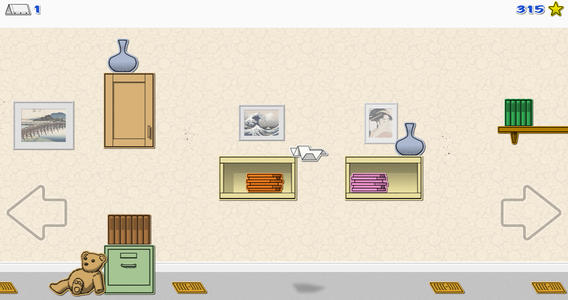Another World
John Calhoun's original Glider series of games, beginning in 1989 and finishing up in the mid-nineties with Glider PRO, were the epitome of Classic Mac gaming. They were full of simple, engaging game play embellished with detailed and idiosyncratic art and sound effects. This simple game play also makes them prime candidates for an iOS adaptation. Originally landing on the App Store in late-2011, this is not a rerelease of the original Glider, but a continuation of the series. It feels very true to the original Glider and it's one of my favourite Classic Mac ports.
Glypha
Another John Calhoun game, Glypha (itself a clone of the arcade game Joust) was released onto the App Store way back in 2009 and hasn't received a single update since. It's been a while since I played Glypha, but I recall it being a bit buggy, like you would get zapped dead for seemingly no reason at random times. Still, I'm including it on this list for completeness and because it's a pretty obscure title.
Lode Runner
Marathon
Bungie's 1994 first-person shooter which would go on to revolutionise the genre, was released for iOS in 2011.
Myst
For an expansive, dense graphic adventure, Myst translates pretty well to the iPhone. When Myst came out, my family had a Mac Plus so we couldn't play this behemoth of a game, but now it's 2014 and I can play it on my phone. (Take that, past me!) There are also a bunch of other iOS ports for Classic Mac titles from Cyan Worlds such as Riven and The Manhole. Still waiting for Cosmic Osmo, though.
Mystery House
A release of an Apple ][ title, Mystery House is a seriously retro, handmade looking game originally from 1980.
Short Circuit
One of my favourite Mac puzzle games ever! Short Circuit is a match-the-tile game released in 1995 that I used to play endlessly on an LCII. It's format makes it perfect for iOS and a port was published by namedfork.net in late-2013. (namedfork.net are also responsible for the Mini vMac - a Mac Plus emulator that can run on a pre-iOS 5.x jailbroken iPhone.)
Spaceward Ho!
A space-based strategy game released in 1990, Spaceward Ho! has quite a cult following (although I've never played it). The iOS port was released in early-2012 and has seen constant updates since.
Spectre
This 3-D multiplayer tank game was released on iOS in 2010 and is being regularly updated. I think some details are a little different to the Spectre I played on our LCII back in the nineties but it's definitely an authentic recreation of the frantic game play of the original (and the frustration at being blown up by hoards of enemy tanks.)
Spin Doctor
Transylvania
A port of another Apple ][ game from 1982. This game features old-school graphics and an 'Obvious exits are NORTH, SOUTH and DENNIS'-style of game play.
Tristan (Pinball)
I played Tristan a lot as a kid but it never occurred to me that it would make it to iOS. Released in 2011 this port is made by Littlewing, the original developers of Tristan, and it's pretty great. There are a few weird additions to this version such as completely unnecessary music, a garish splash page with rotating, random 3-D objects and egregious use of Joker font(?!) but once you hit the play button you will be transported back to 1991 with the faithful recreation of game play and sound effects.
Warlords
Another title from 1991 that has made it's way to iOS. This is a very faithful port of the classic strategy game, allowing you to play on the six original maps with up to eight humans/bots. This title was released in late-2012 and since then has seen regular updates and improvements - its developers appear to be really dedicated to this game and actively engage with users on their Facebook page.
CLASSIC MAC GAMES THAT USED TO BE AVAILABLE FOR iOS BUT ARE NOW LOST:
Crystal Quest - There was a release of this iconic Classic Mac title made available way back in 2008 which has now vanished from the App Store. It was never exactly a great adaptation for the iPhone though - I could never play it for more than a level or two as the mouse-based movement of the ship simply didn't translate to iOS.
Prince of Persia - There was a 'retro' version of this game which was more or less a direct port of the original made for iPhone and was available in 2011. It was unfortunately superseded by the infinitely lame 'classic' version which took the levels of the original game and stuck new, updated graphics over the top, due to absolutely no demand from anybody, anywhere. However, if you did purchase the retro release a few years ago, as I did, if you go into App Store, Updates, Purchased, Not on This iPhone, it may still be lurking in there, able to be downloaded onto your device. I found that even after it was unavailable on the iTunes Store (because the title was 'updated' to the crappy new 'classic' edition) I could download the old one in this way - even onto a new device.
Stuntcopter - An almost exact replica of this simple game written by Duane Blehm in 1986 was released by NerdGames a few years back, but has since similarly disappeared from the App Store. However, you can apparently get a version for OSX (10.4 onwards) from the good people at Antell Software.
Through The Looking Glass (Alice X) - This game is legendary for being one of the earliest games ever written for Mac computers and for it's unique, obscure game play and associated Carrollian imagery. It was written by Steve Capps, one of the original designers of the Apple Mac system, and was released in 1984. The game play is well suited to iOS and a version was released by Capps himself back in 2009. Alas, the game has long been out of print in the iTunes store, despite Capps website still proudly flashing up now-dead links to the game. He does have a Javascript version of the game up and running if you want to give it a play. I've since noticed on Twitter that Capps has said that 'Apple's annual developer tithe made it not worth the effort'. Damn you, Apple! Don't you guys owe Capps a favour or two?







